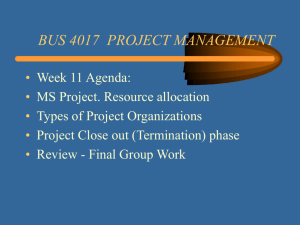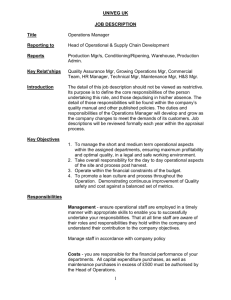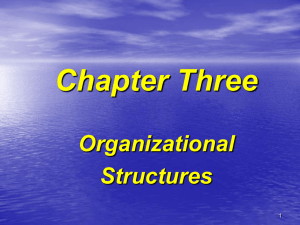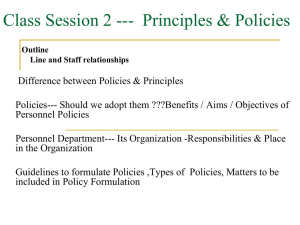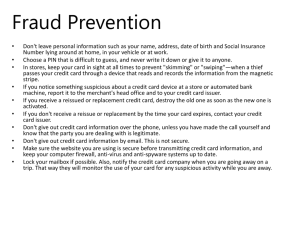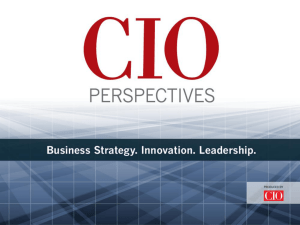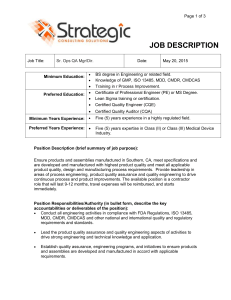Facing the HR Challenges of the 21st Century
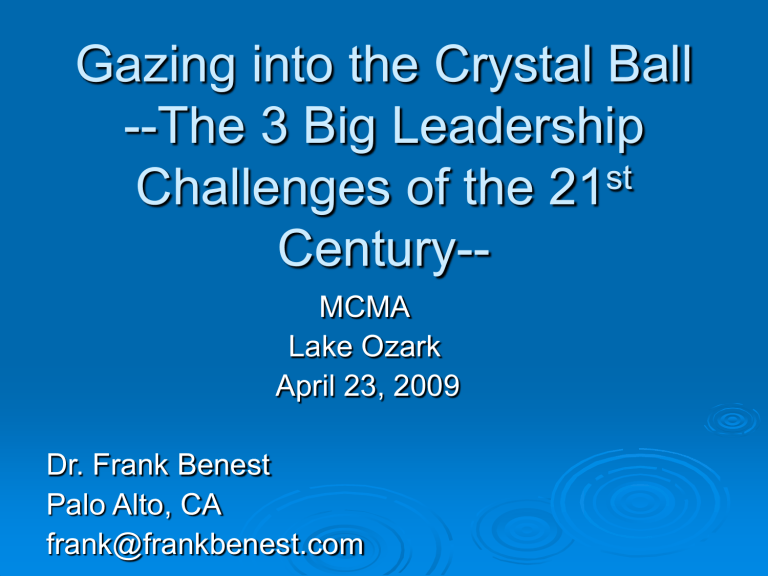
Gazing into the Crystal Ball
--The 3 Big Leadership
Challenges of the 21
st
Century--
MCMA
Lake Ozark
April 23, 2009
Dr. Frank Benest
Palo Alto, CA frank@frankbenest.com
Overview
1.
2.
3.
4.
5.
Trends Impacting Local Government
Premises
Nature of the Leadership Task
Frank’s Big 3 Leadership Challenges
Resources and Questions
Mega-Trends
1.
Select two different mega-trends that have or will have significant impact on local government
(consider demographic, social, economic, political, technological, and value trends)
2.
Identify the continuing or anticipated impacts
Premises
Local governments face a world of accelerating and discontinuous change
Problems we face are complex, divisive, and emotionally-laden
Mega-trends dramatically impact local governments
People have lost confidence in all institutions, including government
Premises
(cont)
No one institution, including government, can solve any major problem
Power is diffuse (“blocking” power)
Local government organizations are facing an era of “permanent fiscal crisis”
Big challenges require more leadership, not more management
The Nature of the Leadership
Task
Big issues of the day are leadership tasks a. Technical work can be addressed by management b. Adaptive work requires leadership
Leadership vs. management
People skills are more important than technical skills
“ Leaders don’t force people to follow—they invite them on a journey.” Charles Lauer
The Importance of People Skills
Top Mgmt Analyt ic Ski lls
Mid Mgmt
Lower Mgmt
80 percent of management failure is related to poor people skills
The Nature of the Leadership Task
(cont)
Given nature of challenges, learning capacity becomes key to success
The primary function of leaders is growing more leaders
Employee and civic engagement becomes paramount
Continuum of Involvement
Informing
One way monologue
Telling/selling
Educating
Presenting technical information
Discerning public opinion
People are not responsible for identifying or carrying out decision or solution
Engaging
Two-way dialogue
Listening/responding/ listening
Learning
Eliciting values, hopes, dreams, concerns, fears
Discerning public judgment
People are responsible for identifying or carrying out decision or solution
Leadership Challenge #1
Collaborating Across Boundaries
Collaborating Across
Boundaries
Big problems cut across boundaries, internally and externally
“Boundrylessness” must become strategic goal for organization
Organizational leaders must take responsibility for larger issues outside their domain and control
Organizations need “external sensing” capability
Collaborating Across
Boundaries (con’t)
Collaborations require building rapport and relationship before problem-solving
Organizations must commit resources to collaborations
Greatness in social sector has more to do with work outside organizational boundaries than internal operations
Leadership Challenge #2
Developing a New Story for the
Permanently Restructuring
Organization
Developing a New Story for the
Permanently Restructuring
Organization
Recognize the Challenge of Constant
Resizing and Restructuring
Create a Story to Imbue Organization with
New Spirit
What Is Our New Story?
In the next five years…
Will our local government shed outmoded programs or outsource certain discretionary services in order to better focus on core services or competencies?
Will we better utilize technology to promote efficiency and civic engagement?
Will we eliminate non-value added process and promote more entrepreneurial style of solving problems?
In the next five years…
Will we sell services to other communities or collaborate with other entities in delivering services?
Will we better engage community partners to solve problems?
Will the local government be able to free up revenue to make new strategic investments?
Developing a New Story
(cont)
Recognize the Challenge of Constant
Resizing and Restructuring
Create a Story to Imbue Organization with
New Spirit
Engage People in Creating New Story
Leadership Challenge #3
Creating Talent Strategy for Your
Local Government
Demographic Crisis Facing Local
Governments in U.S.
The Numbers
80 million Baby Boomers (born 1946-1964) leaving U.S. economy
50 million Gen Xers (born 1965-1981) replacing them
Large talent “replacement gaps”
Age Distribution of Gov. &
Private Sector Workers – 2001
30
25
20
15
10
5
0
<25 25-34 35-44 45-54 55-64 65+
Gov.
Private
City of Palo Alto
Organization Chart
City Manager’s Office
City Manager
Asst to the CM
Asst City Mgr
Asst to the CM
Administrative Asst
Exec Asst to CM
Office Specialist
Public Comm Mgr
Office Specialist -
Reception Desk
Dir Human Res Director Libraries
Dir PW/Cty Eng Fire Chief
Director, ASD Director, CSD (# Dir Pln/Com Envn
Director Utilities Police Chief
City of Palo Alto
Organization Chart
Public Works Department
Administration
Director PW/Cty Engineer
Sr Engineer Asst Mgr Wqc Plnt
Project Engineer Mgr, Lab Svc
Staff Secretary
Supv, Wqc Oper
Office Specialist
Mgr, Wqc Plant
Supv, Wqc Oper
Supv, Wqc Oper
Supv Wqc Oper
Fleet Mgr
Staff Secretary
Asst Fleet Mgr
Mgr, Envrn Comp
Staff Secretary
Mgr, Env Cont Prg
Depty Dir PW Ops Sr Administrator
Mgr, Maint Ops
Refuse
Admin Asst
Asst Dir PW Eng Mgr, Fac Maint/Prj
Sr Engineer Staff Secretary
Mgr, Maint Ops
Operations
Sr Engineer Engineer
Sr Eng Strm Drn Supv Facil Mgt Mgr, Env Cont Prg Sr Engineer
Mgr, Solid Waste
Refuse
Managing Arborist
Project Engineer Supv Bldg Svc
Coord PW Proj Project Mgr
Executive Asst Sr Proj Mgr
Office Specialist Acct Specialist Staff Secretary Supv Insp/Surv
City of Palo Alto’s
“Retirement Wave”
50% of Management and Professional
Employees are eligible to retire in three years
35% say they will definitely retire
A View From The Trenches
1.
What are some indicators of a talent challenge in your organization?
2.
What are the organizational impacts?
Organizational Impacts
Promoted managers or professionals not ready
Difficulty recruiting seasoned managers or professionals
Loss of productivity
Service problems
Loss of institutional knowledge
Increased recruitment and training costs
Loss of organizational capacity
Creating Talent Strategy
1.
2.
Analyze workforce and identify vulnerabilities
Initiate succession planning to respond to “retirement wave” a. Identify talent and accelerate development of aspiring managers b. Transfer knowledge c. Attract young people into local government careers
Creating Talent Strategy
(con’t)
3.
4.
Identify competencies required for future, especially in “pivotal” positions
Retool hiring practices (see “Hiring 2.0”
Guide of Best Practices)
5.
Creating a Talent Strategy
(cont)
Create learning organization a. Provide strong rationale b. Offer array of learning opportunities c. Focus on “doing” d. Provide coaching resources e. Encourage learning plans f. Re-conceptualize role of managers g. Allow for mistakes
6.
7.
Creating a Talent Strategy
(cont)
“Re-recruit” employees
Align all organizational systems to support talent strategy
Resources
Cal-ICMA Coaching Program www.cal-icma.org/coaching
Check out “Hiring 2.0” Guide
ICMA Next Gen resources www.icma.org/nextgen
Articles —contact Frank at frank@frankbenest.com
“Creating a New Future for the Downsizing
Organization”
“Retaining and Growing Talent—Strategies for
Creating Organizational Stickiness”
Good to Great and The Social Sectors, Jim
Collins, 2005
Follow-Up Action
“As a result of this workshop, what is one idea that I would like to incorporate into my city management practice?”
Wrap-Up
Questions?
Perplexing issues?
Thank You!
www.frankbenest.com

